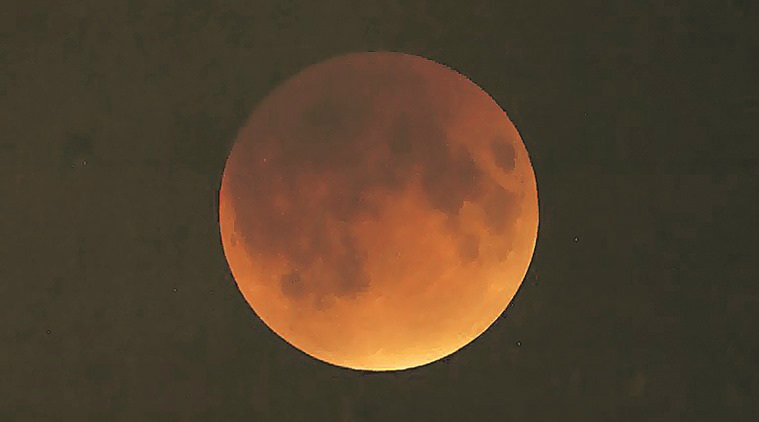Total lunar eclipse on July 27, 2018: Century’s longest eclipse, blood moon and what happens
Total Lunar Eclipse on 27-28 July 2018: Here is why this month's Blood Moon and lunar eclipse will be the most unique one of the century.

Lunar Eclipse July 2018: A blood moon will be witnessed as a total lunar eclipse takes place on the night of July 27, and the early hours of July 28. (File Photo)
A total lunar eclipse will take place on the night of July 27, and the early hours of July 28. The big difference is that the lunar eclipse on July 27 is expected to be the longest blood moon witnessed in 100 years. The Moon will be visible in a scarlet red hue for over 1 hour and 43 minutes, which is 40 per cent longer than any other blood moon measured in recent times.
In addition, these dates will also see the opposition of Mars, which is being observed after 15 years. The last opposition of Mars, which means the Sun, Earth and the Red planet are lined up, was seen in 2003.
While these phenomena will be visible across different parts of the world, many have wondered why this this lunar eclipse is different from the previous ones, including the January 31 Super Blue Blood Moon. Here’s why and how the Lunar eclipse in July 27 will be unique.
Lunar Eclipse July 27-28 blood moon: What will happen?
Over the night of July 27 and July 28, the Moon will fall totally into the Earth’s shadow. The lunar eclipse will be visible in South America, East Africa, the Middle East and central Asia. The eclipse can also be observed in India, and we have details on the timings below.
The Earth’s satellite appears to be red in colour, during a total lunar eclipse when no sunlight falls on the surface of the Moon and it is completely under the Earth’s shadow. What happens is that sunlight from Earth’s surface falls on the surface of the Moon, but when it is seen on Earth, the Moon appears red.
The reason: the Earth’s atmosphere will scatter light of the smaller wavelength like blue and green, but allow the red light, which is of longer wavelength, to pass through to the satellite’s surface. That’s why the Moon looks red in colour during the total lunar eclipse.
As far as its duration is concerned, the moon will remain at the perigee, which is the most distant point in its orbit around Earth. Due to this, the Earth’s shadow will be larger at the perigee, than it would be at any other point of the Moon’s elliptical orbit.
Lunar Eclipse on July 27-28: How to watch, timings, etc for India
On July 27, the Moon will be hidden from the Sun by the Earth. This will create a lunar eclipse, as the Earth comes in between the Moon and the Sun. The eclipse will last beyond the blood moon, as parts of the Moon will fall under the Earth’s shadow before and after the total eclipse. The partial lunar eclipse will be visible before the blood moon sets in, and after it ends.
The July 27 blood moon will be visible in India for its entire duration. The first phase of the partial lunar eclipse will be visible from 11.43 pm on July 27, and is expected to last until 1 am on July 28. At this point, the blood moon is expected to set, which could last till 2.43 am. This is when the Moon is completely under the Earth’s shadow and will turn on a reddish colour.
After this, the second phase of the partial lunar eclipse will be seen until 3.49 am. Experts have warned, though, that the level of visibility for the blood moon will be limited. The Indian Express reported that quoting Dr Arvind Paranjpye, the director of Nehru Planetarium, Mumbai, these celestial events would be tough to witness, given the cloud cover from the ongoing monsoons, especially in cities in Western India like Pune.
Both events will be best captured away from city limits, as that reduces the chances of a polluted sky. While the blood moon and Mars inversion does not require the aid of special eyewear, it is recommended that skygazers use telescopes, to get their best glimpse of these phenomena.
Read more: Blood moon, blue moon and black moon: How these lunar phenomena are caused, how they are named
Mars inversion on July 30
At the end of this month, stargazers will also be witness to the inversion of Mars. This is the phenomena, during which the Earth comes between Mars and the Sun. The last Mars inversion was witnessed in 2003, and this phenomenon will not be viewed again before 2035, according to Journal Sentinel.
During a Mars inversion, our planet is at its closest to the Red Planet, which would be about 35.8 million miles It is expected to rise below the Sagittarius constellation, and will also appear brighter than most stars. This event might cannot be observed by the naked eye. This is because Mars is undergoing a planet-wide dust storm, images of which have been captured by NASA’s Curiosity rover. Stargazers should consider peeking through a telescope to observe the event.
For all the latest Technology News, download Indian Express App
© IE Online Media Services Pvt Ltd






















No hay comentarios:
Publicar un comentario